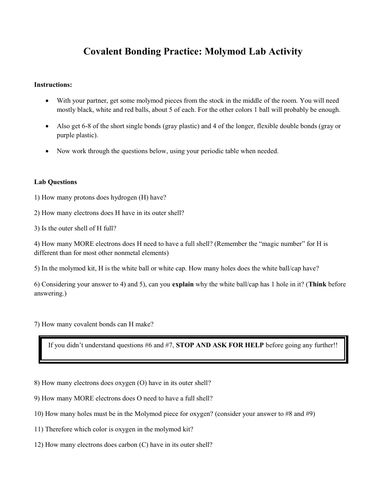



This is a pair-based activity intended to teach students about covalent bonding and molecular structures, using the Molymod model building pieces. It is very carefully scaffolded, starting with very easy questions to build confidence, then by the end students are dealing with advanced concepts like isomerism and ring strain. Note that molymod kits are absolutely required (see Supplies below), however if your school does have these, it squeezes a tremendous amount of educational benefit out of them. In my opinion, over a 30-year teaching career this is one of the most effective resources I have ever created; I have used it with several classes in multiple countries and it never fails to have most students highly engaged, building molecules and racing to finish the questions.
**Topics: **
covalent bonding, molecular structure, single vs. double vs. triple bonds, effect of bonding on molecular shape, VSEPR theory; isomerism; organic rings; ring strain
Required supplies:
- Molymod kits sufficient for your class size. Each pair requires approximately 5 black carbon pieces, 5 red oxygen pieces, around 6 white hydrogen pieces; 2 blue nitrogen pieces; and 2 green chlorine (halogen) pieces. About eight of the gray plastic single bond pieces and 4 or so of the gray plastic double bond pieces are also needed. Having said that, if you are short of pieces you can simply use larger groups, although I don’t recommend this as it creates a “spectator effect” where some students might just be watching and not building. (Note: molymod kits are available from Amazon, Philip Harris, etc.)
- Periodic tables for each pair
- 60-80 min of class time
Recommendations for use of resource:
Before beginning this activity, students should already have a basic understanding of atomic structure (particle composition of different elements) and covalent bonding (so the idea that “full shell means stable” should be somewhat familiar to them).
As mentioned, your school must have a sufficient supply of molymod kits for the class.
Print out sufficient copies of the activity handout for each pair of students. It is designed to fit on 4 pages, so if you use double sided printing only two sheets per pair are required.
Show the molymod kits to the students, point out that different elements are represented by different colors, and build a simple molecule like water as an example.
Then stand back and let them get on with it. I have found that 60-80 minutes are sufficient for most pairs to complete all 4 pages.
Assessment:
- A full mark scheme is provided; I personally assess it with 58 required points and 19 additional “bonus points” available. If your assessment scheme does not allow grades exceeding 100%, then you can simply make the bonus parts optional enrichment, or allow students attempting them to demonstrate answers to the class.
- Due to the hands-on nature of this activity I consider it part of their lab grade, even though no “wet” chemicals are used.
Something went wrong, please try again later.
This resource hasn't been reviewed yet
To ensure quality for our reviews, only customers who have purchased this resource can review it
Report this resourceto let us know if it violates our terms and conditions.
Our customer service team will review your report and will be in touch.